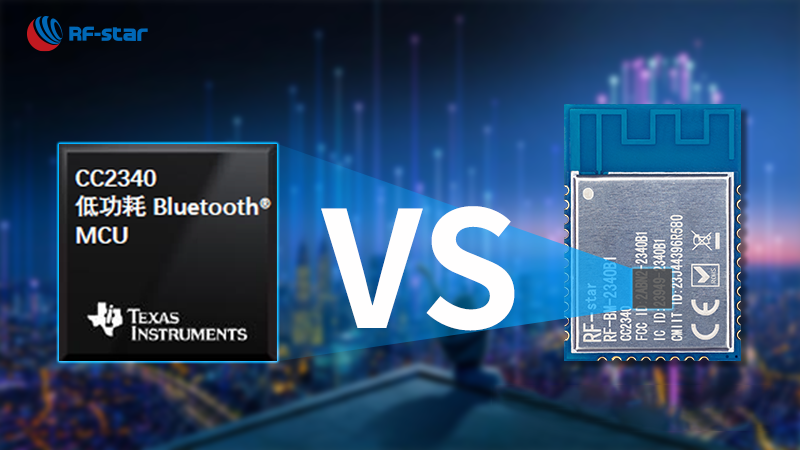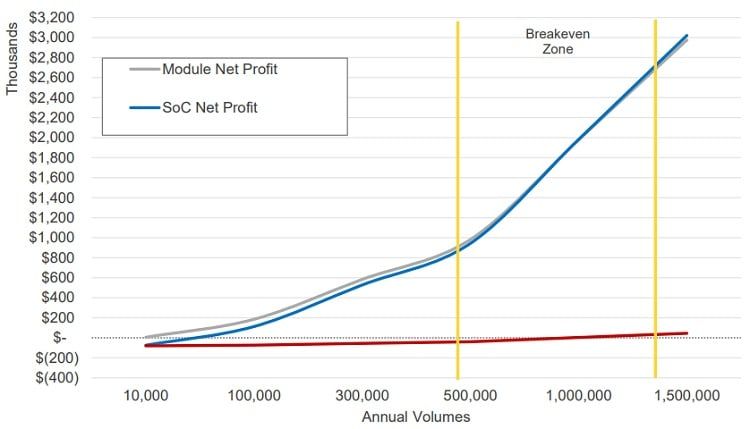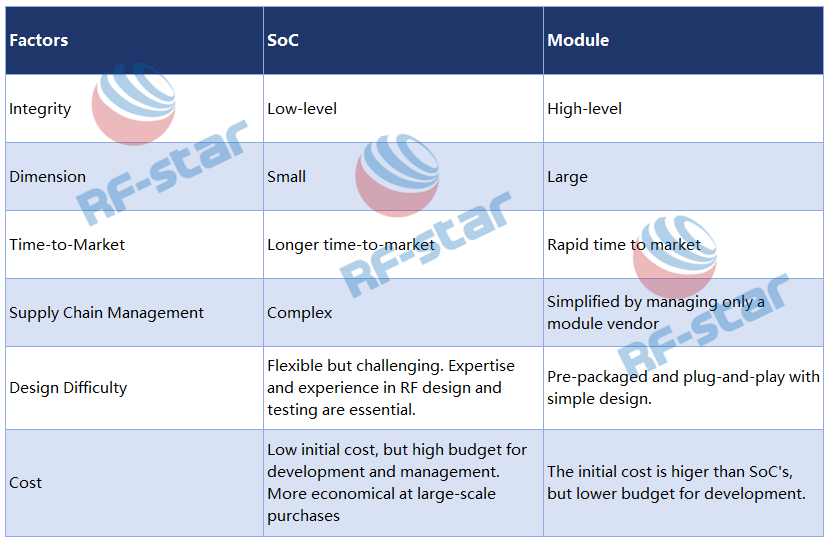Bluetooth LE モジュールとシステムオンチップ (SoC)のどちらを選択するかは、Bluetoothデバイスの設計において重要かつ難しい決定です。各オプションには独自の利点と欠点があるため、パフォーマンス、機能、コストを慎重に比較検討することが不可欠です。
Bluetooth 技術の熟練した専門家として、RF - star はBluetooth チップセットとモジュールの詳細な比較を提供することで、意思決定プロセスを簡素化することを目指しています。このガイドは、生産量、技術的専門知識、予算、市場投入までの時間に基づいて最適な選択を行うのに役立ちます。
Bluetoothシステムオン チップ (SoC) は、デバイス内で Bluetooth 通信を可能にする集積回路(IC)です。通常、コア プロセッサ、RF トランシーバー、メモリ、補助回路が含まれます。SoCはBluetooth 通信の中心として機能し、データの送信と処理を管理します。
対照的に、Bluetooth LEモジュールは、包括的で低電力のBluetooth通信ソリューションとして機能する事前認証済みのユニットです。Bluetooth LE SoCと、プリント回路基板(PCB )上のRF回路、水晶発振器、アンテナ整合回路、アンテナ、バラン、周辺機器インターフェイスなどの追加コンポーネントを統合しています。モジュールは、事前にパッケージ化されたプラグアンドプレイソリューションであり、製品開発を大幅に簡素化し、開発者が基礎となるRF設計を気にすることなく、より高レベルの製品機能に集中できるようにします。

TI CC2340 SoC & RF-star RF-BM-2340B1 モジュール サンプル
Bluetooth LEモジュールと SoCの違いを比較するために、次の主要な指標を使用します。
Bluetooth SoC は Bluetooth 通信に不可欠な機能を提供しますが、完全に機能するシステムを作成するには追加の周辺コンポーネントが必要です。SoC を選択する開発者は、必要な RF 回路、電源管理、組み込みソフトウェアを設計して実装する必要があります。
このレベルのカスタマイズは、製品のフォーム ファクター、消費電力、パフォーマンスを細かく調整する必要がある場合に役立ちます。ただし、開発サイクルが長くなることも意味し、プロジェクトには RF 設計と組み込みソフトウェア開発の専門知識を持つチームが必要になる場合があります。
一方、Bluetooth モジュールには、Bluetooth 5.0 シリアルポートファームウェア、UART ダイレクトドライブファームウェア、SPI透過伝送ファームウェア、I2C ファームウェアなどの周辺 RF 回路と関連する組み込みソフトウェアが統合されています。開発者は外部 MCU を使用して Bluetooth接続を直接制御できるため、製品開発の作業負荷と複雑さが大幅に軽減されます。これにより、開発者はアプリケーション層に集中し、Bluetooth 接続をより迅速に製品に統合できます。
Bluetooth シリアル ポート モジュールについて詳しくは、ブログ「汎用シリアル通信プロトコル: UART、SPI、I2C」をご覧ください。
Bluetooth Low Energyモジュールは、使いやすさを念頭に置いて設計されています。多くの場合、UART、SPI、I2C、GPIO などの標準化されたハードウェア インターフェイスとソフトウェア プロトコルを備えているため、さまざまなシステムに簡単に統合できます。
さらに、Bluetooth LEモジュールには通常、広範なドキュメント、開発キット、リファレンス デザインが付属しており、開発プロセスがさらに容易になります。多くのモジュールには、必須の Bluetooth プロファイルとサービスをすぐに使用できる堅牢なソフトウェア スタックも付属しています。つまり、Bluetooth の経験があまりない開発者でも、ワイヤレス接続を製品に統合できます。
対照的に、Bluetooth SoC を使用するには、より高度な技術的専門知識が必要です。開発チームは、RF ハードウェアと組み込みソフトウェアの設計に精通している必要があります。これには、RF 回路の作成、コンポーネントの選択と配置、電力の最適化、Bluetooth 準拠の確保が含まれます。このアプローチは、大量生産において柔軟性と潜在的なコスト削減をもたらしますが、より多くの時間、リソース、専門知識が必要になります。
Bluetooth LE SoC とモジュールのどちらを選択するかは、アプリケーションによって大きく異なります。Bluetooth モジュールは、特に利便性と開発時間の短縮が単価の高さを上回る中程度の生産量の場合、最小限の労力でワイヤレス接続を実装するのに最適です。
Common applications for Bluetooth LE modules include smart home devices, such as smart plugs, light bulbs, and security cameras; smart medical devices, such as blood glucose monitors and digital thermometers; and industrial IoT devices, such as sensors and actuators that require reliable wireless communication.
Bluetooth SoCs, however, are better suited for applications that require high customization, integration, and scalability. They are often used in large production volumes, where cost savings from using SoCs are substantial.
Typical applications include high-performance consumer electronics, such as smartphones, tablets, and laptops; wearable devices, such as smartwatches and fitness trackers; and automotive applications, such as in-car entertainment systems and advanced driver-assistance systems (ADAS).
Cost is often a decisive factor in choosing between a Bluetooth SoC and a module. Bluetooth modules with pre-certified RF circuitry, an antenna, and a software stack may raise the cost of buying one. Its initial purchase cost sounds higher than SoC’s.
However, this higher cost should be weighed against the potential savings in development time and resources. When using a Bluetooth SoC, the following development-related expenses should be taken into consideration:
While SoC might have a lower initial cost, it can incur additional expenses during development.
For large-scale production, however, the higher upfront investment in development can lead to significant cost savings in the long run. According to an analysis by Silicon Labs, SoCs may offer a cost advantage over modules when annual production volumes exceed 500,000 to 1.3 million units. This makes SoCs an attractive option for high-volume products where reducing the bill of materials (BOM) cost is critical to maintaining profitability.

Break-even for a wireless SoC and wireless module. Source from Silicon Labs
Supply chain management is another crucial consideration when choosing between a Bluetooth chipset and a module.
With a Bluetooth LE module, you only need to manage the module vendor, who is responsible for ensuring the module's quality, availability, and compliance with industry standards.
しかし、SoC ベースの設計では、SoC プロバイダー、 PCB メーカー、アンテナ サプライヤーなど、複数のサプライヤーを管理する必要があります。これらのサプライヤーはそれぞれリード タイム、製品ライフサイクル、品質管理プロセスが異なる場合があり、サプライ チェーン管理が複雑になり、より多くのリソースが必要になります。

Bluetooth LE モジュールと SoC の包括的な比較
上記の比較に基づいて、Bluetooth SoCと Bluetooth モジュールのどちらを選択するかを決定する際には、いくつかの重要な要素を考慮する必要があります。
まとめると、Bluetooth SoCとモジュールはそれぞれ長所と短所を持っています。どちらが優れているのでしょうか?それは、特定の製品、開発チーム、製品発売の緊急性、予算、生産量などによって異なります。意思決定プロセス中に質問がある場合は、モジュールと SoC の両方を備えたBluetooth LEソリューションの大手プロバイダーである RF-starが、コスト、スケジュール、製品パフォーマンスに関するガイダンスを提供して、最適な選択を行うお手伝いをします。